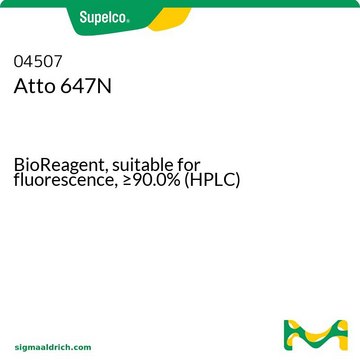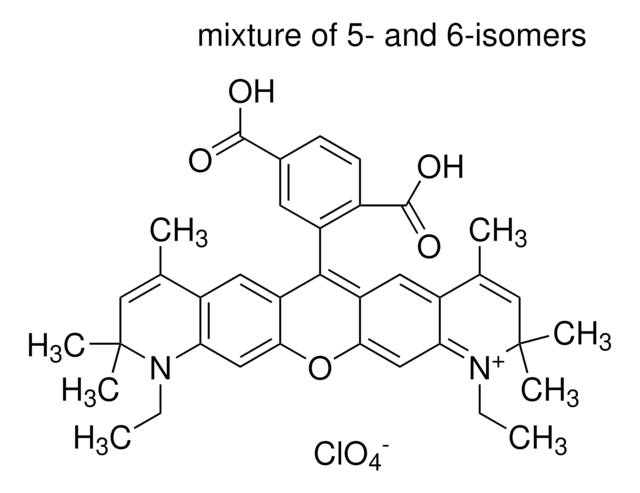42424
Atto 550
for fluorescence, ≥90% (HPLC)
Iniciar sesiónpara Ver la Fijación de precios por contrato y de la organización
About This Item
Productos recomendados
grade
for fluorescence
Quality Level
assay
≥90% (HPLC)
form
powder
manufacturer/tradename
ATTO-TEC GmbH
λ
in ethanol (with 0.1% trifluoroacetic acid)
UV absorption
λ: 553-559 nm Amax
storage temp.
−20°C
General description
Atto 550 hat eine molekulare Absorption von 120.000 und eine Quantenausbeute von 80% in Wasser, so dass er starke Fluoreszenz zeigt.
Die Abklingzeit der Fluoreszenz beträgt 3.2 ns.
Die Abklingzeit der Fluoreszenz beträgt 3.2 ns.
Application
Atto fluorescent labels are designed for high sensitivity applications, including single molecule detection. Atto labels have rigid structures that do not show any cis-trans-isomerization. Thus these labels display exceptional intensity with minimal spectral shift on conjugation. Atto 550, which is similar to Cy3™, may be useful in applications such as fluorescence resonance energy transfer (FRET) and as a tag for molecules such as secondary antibodies.
Legal Information
This product is for Research use only. In case of intended commercialization, please contact the IP-holder (ATTO-TEC GmbH, Germany) for licensing.
CAB-O-SIL is a registered trademark of Cabot Corp.
Cy3 is a trademark of Cytiva
Storage Class
11 - Combustible Solids
wgk_germany
WGK 3
flash_point_f
Not applicable
flash_point_c
Not applicable
ppe
Eyeshields, Gloves, type N95 (US)
Elija entre una de las versiones más recientes:
¿Ya tiene este producto?
Encuentre la documentación para los productos que ha comprado recientemente en la Biblioteca de documentos.
Los clientes también vieron
Smart-aggregation imaging for single molecule localization with SPAD cameras.
Gyongy, I.; et al.
arXiv (2016)
Antibody transfection into neurons as a tool to study disease pathogenesis.
Douglas JN, Gardner LA, et al.
Journal of Visualized Experiments, 26, 4154-4154 (2012)
Sandeep Kumar Vashist
Analytical biochemistry, 421(1), 336-338 (2011-11-19)
A surface plasmon resonance (SPR)-based procedure was developed to determine the effect of antibody modifications on its biomolecular binding behavior. Mouse immunoglobulin G (IgG) was immobilized on a protein A-functionalized gold-coated SPR chip. Goat anti-mouse IgG and its various commercially
Michel Frigoli et al.
Chemistry (Weinheim an der Bergstrasse, Germany), 15(33), 8319-8330 (2009-07-04)
Core-shell type dual fluorescent nanoparticles (NPs) in the 16 nm diameter range with a selective ligand (cyclam) attached to the surface and two fluorophores--9,10-diphenyl-anthracene (donor, D) and pyrromethene PM 567 (acceptor, A)--embedded within the polymer core were synthesized and their
Robert H Meltzer et al.
Lab on a chip, 11(5), 863-873 (2011-01-21)
Rapid, specific, and sensitive detection of airborne bacteria, viruses, and toxins is critical for biodefense, yet the diverse nature of the threats poses a challenge for integrated surveillance, as each class of pathogens typically requires different detection strategies. Here, we
Nuestro equipo de científicos tiene experiencia en todas las áreas de investigación: Ciencias de la vida, Ciencia de los materiales, Síntesis química, Cromatografía, Analítica y muchas otras.
Póngase en contacto con el Servicio técnico





